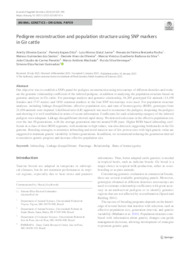Pedigree reconstruction and population structure using SNP markers in Gir cattle.
Pedigree reconstruction and population structure using SNP markers in Gir cattle.
Author(s): GARCIA, A. O.; OTTO, P. I.; GLATZL JUNIOR, L. A.; ROCHA, R. de F. B.; SANTOS, M. G. dos; OLIVEIRA, D. A. de; SILVA, M. V. G. B.; PANETTO, J. C. do C.; MACHADO, M. A.; VERNEQUE, R. da S.; GUIMARÃES, S. E. F.
Summary: Our objective was to establish a SNPs panel for pedigree reconstruction using microarrays of different densities and evaluate the genomic relationship coefficient of the inferred pedigree, in addition to analyzing the population structure based on genomic analyses in Gir cattle. For parentage analysis and genomic relationship, 16,205 genotyped Gir animals (14,458 females and 1747 males) and 1810 common markers to the four SNP microarrays were used. For population structure analyses, including linkage disequilibrium, effective population size, and runs of homozygosity (ROH), genotypes from 21,656 animals were imputed. Likelihood ratio (LR) approach was used to reconstruct the pedigree, deepening the pedigree and showing it is well established in terms of recent information. Coefficients for each relationship category of the inferred pedigree were adequate. Linkage disequilibrium showed rapid decay. We detected a decrease in the effective population size over the last 50 generations, with the average generation interval around 9.08 years. Higher ROH-based inbreeding coefficient in a class of short ROH segments, with moderate to high values, was also detected, suggesting bottlenecks in the Gir genome. Breeding strategies to minimize inbreeding and avoid massive use of few proven sires with high genetic value are suggested to maintain genetic variability in future generations. In addition, we recommend reducing the generation interval to maximize genetic progress and increase effective population size.
Publication year: 2023
Types of publication: Journal article
Unit: Embrapa Dairy Cattle
Keywords: Bovino, DNA, Endogamia, Gado Gir, Marcador Genético
Observation
Some of Embrapa's publications are published as ePub files. To read them, use or download one of the following free software options to your computer or mobile device. Android: Google Play Books; IOS: iBooks; Windows and Linux: Calibre.
Access other publications
Access the Agricultural Research Database (BDPA) to consult Embrapa's full library collection and records.
Visit Embrapa Bookstore to purchase books and other publications sold by Embrapa.

